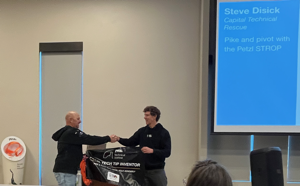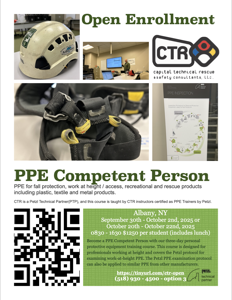

We’re back from an incredible few days at the Petzl Technical Partner (PTP) Camp, and we couldn’t be more excited about what’s ahead. This event brings together Petzl Technical Partners from across the industry and globe for hands-on workshops, gear innovation, and knowledge sharing—all aimed at advancing safety and efficiency in rope access and rescue.

Become a PPE Competent Person with our three-day personal protective equipment training course. This course is designed for professionals working at height and covers the Petzl protocol for examining work-at-height PPE. The Petzl PPE examination protocol can also be applied to similar PPE from other manufacturers.

Our "Rescues Gone Wrong" class at SOCON 2025 offered challenging, scenario-based rescue training that was well-received by participants. Due to popular demand, we're excited to announce an expanded two-day session next year!

March 2025 | Salt Lake City, UT
We are excited to announce that Capital Technical Rescue (CTR) as part of the Petzl Technical Partner (PTP) network, can now offer the Petzl PPE Competent Person Training Course! This milestone comes after our dedicated staff traveled to the Petzl Technical Institute (PTI) in Salt Lake City, Utah, in March 2025 for an intensive certification course. Our team is now equipped to deliver top-tier training in personal protective equipment (PPE) management and inspection.

We are excited to announce our participation in the New York State Technical Rescue Conference, scheduled for May 29th to June 1st, 2025, at the State Preparedness Training Center in Oriskany. This event is a fantastic opportunity for professionals in the emergency services field to enhance their skills and knowledge.

We’re excited to announce that our team is now equipped with new Petzl Vertex Hi-Viz helmets featuring our logo alongside our prestigious recognition as a Petzl Technical Partner! 🎉

Elevating Rescue Skills at the 2024 New York State Technical Rescue Conference
We are thrilled to share highlights from our recent training sessions at the 2024 New York State Technical Rescue Conference! Our team at Capital Technical Rescue not only showcased our "Confined Space Tricks of the Trade" program but also introduced our innovative "Forgetting AZTEKs" program.

This week, our Capital Technical Rescue team embarked on an exciting three-day tripto Sterling Rope in Maine, where we had the opportunity to expand our knowledge and enhance our skills in rope and rescue systems.

Steve
🎉🔗 Exciting Announcement from Capital TechnicalRescue and Safety Consultants, LLC (CTR)! 🔗🎉
We are thrilled to share that CTR has officially joined the prestigious Petzl Technical Partner (PTP) network! 🌟 As a member of this esteemed network, we are committed to upholding the highest standards of technical proficiency, safety, and innovation in the industry.

Steve Disick
Excited to announce we are once again presenting at the Technical Rescue Conference at the NYS DHSES State Preparedness Training Center - June 3rd - 5th, 2022!!
This year we will be presenting two 180 minute hands on workshops 1. Rigging Challenges and 2. Small Teams / Efficiency in Rescue.

Cliff Freer
It is the responsibility of every Rope Rescue Operator and Technician to determine if the system they are utilizing is “safe”. There has long been the misnomer that our “Safety Factors” for rope rescue in the fire service were required to be 15:1.

Steve Disick
We are excited to announce multiple Open Enrollment courses and clinics that can take you or your team members from basic rescue knowledge to advanced specialty clinics. All of these courses are on our website now and are open for registration.

Steve Disick

Pete Hall
So today you’re riding the jump seat of Engine 6 and you take in a call for a “man down”, “no further info”. On arrival you see a utility truck parked next to a manhole with no one around. On further investigation you see two men slumped over at the bottom of the hole. What do you do next?
With an average of 67 deaths a year (1 every four days!) coming from confined spaces and almost 60% coming from would be rescuers, its clear that letting your guys dive into the hole is not the answer.
So lets back up, what is a confined space?

Pete Hall
So you are paddling your IRB in some class 3 rapids and suddenly things go sideways, your boat flips. Thankfully the equipment is all secured safely to the craft per your Department’s SOPs. But now you find yourselves in a defensive position heading downstream clinging to an upturned craft. How will you right it?
Ok, so this is not as dramatic as it all sounds, righting your craft can be done quickly and easily following a few simple steps

Cliff Freer
Over the years we’ve had the opportunity to train in some great facilities. We’ve been given access to a kiln in a concrete plant, a pulp digester in a paper mill and a 60 ton gantry crane in a container port, just to name a few. We’ve also struggled to find good training sites to ensure that the training would be realistic, informative and challenging. With those lessons learned we started making plans to build a training facility that we could host clients in that would provide a realistic and challenging environment.

Pete Hall
Five minutes into a seemly routine fire in a small two family you hear a crew on the floor above you call a MAYDAY. It’s a quick transmission and you were not quite ready to hear it, you didn’t hear the details and there is no follow up….
This is potentially one of the most stressful and challenging moments we can come across in our career. Hearing, or worse having to call a MAYDAY.
First up let’s deal with the stigma of even calling a mayday in the first place. We all know we work in an environment where peer pressure is at its highest, it’s what makes us want to improve ourselves, impress our peers with our skill set and knowledge. But could it hurt us? Could we be put in a situation that has all the potential to go bad and be reluctant to call for help at the fear of a bit of healthy ribbing after? Sure we could, sitting here reading a witty blog its easy to see that’s a bad idea, and a little (or even a lot) of teasing down the road is worth going home to our loved ones. Another reason we may not call is thinking we can fix the issue and get out alone. Wouldn’t it be better to have the help coming early and turn them away if they are not needed? The take away is, if we think we are in trouble, or could be in trouble soon, we should make the call. OK, I think we all get the message.

Pete Hall
We never know what we are going to find ourselves doing here at CTR. We could be running boats in the Long Island sound, crawling through a deliberately collapsed house in Vermont or standing by to drag someone from a permit required confined space. Back in the spring however we got to take on a new job, one for which we had not been tasked with before, we stood by, ready to save Bacon!
Kevin Bacon and his friends (when I say friends, I mean the production company and staff) were filming a chase scene for the season finale of the TV show “The Following” in downstate New York. They had worked up an exciting stunt that involved a potential fall in the Croton River, and had nicely asked us if we could come play also. How could we say no to Kevin Bacon?

Cliff Freer
The fire service is an amazing and rewarding profession with limitless potential. Like many other professions we face challenges that go way beyond our responses. Unions fighting for salaries, manning, training and equipment. Insurance prices increase to the same proportion as our benefits decrease. We have an enormous amount of latitude while we are operating at the scene of an emergency to accomplish our goals and occasionally we get injured and sometimes it’s much worse. That will always be as noble as it is regrettable. First Responders work in hazardous environments. That requires us to simulate these environments as best we can to achieve realistic and effective training. When someone gets injured it always forces us to take that moment to pause, that gut check that we did right by the people we are responsible for. Risk can rarely be eliminated completely but with a good look how we manage and setup our training environments we can get close while still providing excellent training.

Cliff Freer
There are a lot of great products out there. There are a lot of inspired, very smart people out there that have this knack for design and function that, well to put it simply, can make our jobs easier and safer. That being said, we need to cautious about buying in to every new piece of equipment on the market.